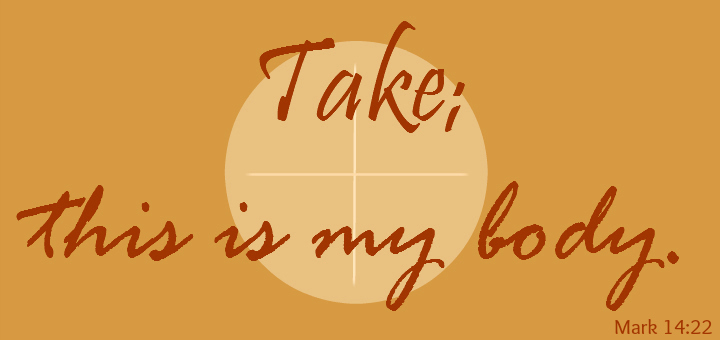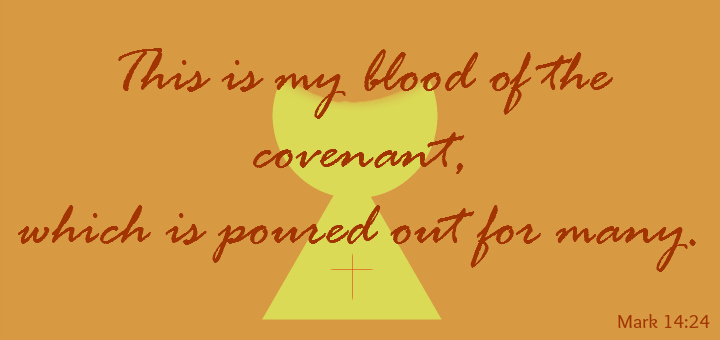It's a crazy story.
While they were eating, Jesus took a loaf of bread, and after blessing it he broke it, gave it to the disciples, and said, ‘Take, eat; this is my body.’ Then he took a cup, and after giving thanks he gave it to them, saying, ‘Drink from it, all of you; for this is my blood of the covenant, which is poured out for many for the forgiveness of sins.
Matthew 26: 26-28
Jesus, taking ordinary bread, thanks his Father, breaks it with the words,
 Image copyright (2016) Jane Korvemaker. All rights reserved.
Image copyright (2016) Jane Korvemaker. All rights reserved.
He then takes the cup and proclaims similarly:
 Image copyright (2016) Jane Korvemaker. All rights reserved.
Image copyright (2016) Jane Korvemaker. All rights reserved.
We know it’s real. And yet we don’t always recognise Jesus there. I think that sometimes it is too overwhelming to be fully present to this miracle – kids are screaming, one is telling us they need to go pee, or one is ripping hymnals apart…all at the wrong times, not to mention all the baggage I came into church with and am still stewing over!
And sometimes I think that I'm almost in a state of suspended belief to that which is so opposite to our senses: 'Jesus’ flesh? His blood? Yes, I believe, but God, it’s on faith and not because I’m seeing it – I believe but it’s hard to believe fully when my senses tell me something very different. How about this compromise, God – I believe this spiritually. At least for now.' There have been days/weeks where my prayer has been to receive Jesus as best as I can, and sometimes that is all we can do.
Jesus called us blessed to believe by faith alone, and so we are! The miracles are amazing confirmations of this blessed faith, opportunities for us to grow deeper and fall in love with Jesus all over again. When we witness these miracles in everyday life, they give us a renewed sense of ‘YES!’ to the transcendental power and beauty of God. It doesn’t mean that we didn’t believe before, but it certainly is encouraging when we can get a kick in the pants to be closer to God through them.
The Miracle of Sokółka
From the official statement from the Metropolitan Curia (the archdiocese) of Białystok:
On October 12, 2008, a priest distributing Communion dropped a consecrated Host. He picked it up and, as per normal protocol when a consecrated Host is not consumable, placed it in a vessel filled with water and put it in the tabernacle. After Mass, the sacristan changed the vessel holding the Host to something safer and it was placed in a safe in the sacristy.
On October 29, 2008, the vessel was placed in the tabernacle of the rectory's chapel. The next day the Host was placed on a white corporal with a small red cross in the centre and placed back in the tabernacle.
On January 7, 2009, the sample of the Host was analyzed by two professionals separately, at the University of Medicine of Białystok. They issued a common declaration stating: ‘The sample sent for evaluation looks like myocardial tissue. In our opinion, of all the tissues of living organisms this is the one that resembles it the most.’
The Commission and the professionals both have found that intervention has not played a part in this event. The Commission has stated, the case of Sokółka does not contradict the faith of the Church, but rather confirms it.
Click here to read more about this miracle in detail and view pictures.
I have been finding myself in a cloud of stunned amazement. It’s not that I haven’t heard about Eucharistic Miracles before, but this one has touched me in a way that others haven’t. More likely, I’m in a place that Christ has revealed himself to me through contemplation of this miracle, and it comes through Christ’s all-loving touch in knowing when I might best respond to his call.
In response to reading about this miracle, I did as any other person would: I googled more Eucharistic Miracles. I wanted some context: does this happen regularly or is it really rare? How do they ascertain that it is of human origin? What’s the process look like? Question after question kept rising up. And it turns out, most of my questions were answered.
Do Eucharistic Miracles happen regularly?
From what I’ve read, it’s possible to say reasonably so. There are many documented ones that go beyond the years I was interested in, but there are 4 recent ones regarding the miracle of the consecrated Host changing its visible form, starting from 1991.
How do they ascertain that it is of human origin?
Typically part of the changed host is sent away to a third party for examination. Surprisingly (even to me – a believer) each report back has indicated striking similarities to each of the other Eucharistic Miracles that have been third-party analyzed. This analysis is typically by professional scientists in the field of histopathology associated with a hospital or university. In the case of Sokółka, it was Professors Maria Elżbieta Sobaniec-Łotowska and Stanisław Sulkowski from the Medical University of Białystok. They were the ones who determined the information about the tissue.
What does the process look like?
Here is where my lay-person’s research came to a bit of a block. Ultimately, it is up to the bishop of the diocese whether they pursue analysis or not, firstly. How that analysis is done depends on how the bishop (and likely the commission that would be set up to investigate) approaches it. It's unclear in the information whether these professors knew beforehand whether the sample they were analysing came from a changed consecrated Host. In other cases (such as Buenos Aires, Argentina) the tissue was submitted without knowledge of the consecrated Host.
As hard as I tried to find the documents of analysis, I could not (and I may have wasted more time looking these up than a normal person would be inclined to). I have to admit it was a little frustrating that these documents are not easily available for the public to read (and be amazed by!). However, to the best of my knowledge, the most recent Eucharistic Miracles that are approved are from Betania, Venezuela (1991), Buenos Aires, Argentina (1992, 1994, 1996), Tixtla, Mexico (2006), and Sokółka, Poland (2008). For more information about these and other Eucharistic Miracles (including pictures), I suggest going through the website called The Real Presence.
I have found myself pondering more and more the mystery of Christ in the Eucharist since hearing about this miracle. I have caught myself thinking about it throughout the day and wondering how I might be able to sneak in a Mass sometime during the week, just to be with him again. Contemplation of this Eucharistic miracle has brought me into contemplation of Christ himself. And as always, he's been there waiting for this encounter. Jesus is waiting for us to bring our thoughts to him - let's bring our thoughts and our whole selves to him as we open ourselves to being surprised by Jesus - surprised by the Good News.
For now, I leave you with this infographic I made about these recent Eucharistic Miracles and pray that you, too, might be opened up to an encounter with the living Christ the next time you receive Eucharist or find yourself googling everything you can on Eucharistic miracles.


This work is licensed under a Creative Commons Attribution-NonCommercial-NoDerivatives 4.0 International License.
Copyright 2016 Jane Korvemaker.
About the Author

Jane Korvemaker
Jane Korvemaker loves food, family, wine, and God (perhaps not in that order). She holds a Certificate in Culinary Arts, which pairs perfectly with her Bachelor in Theology. A former Coordinator of Youth Ministry, she writes from the beautiful and cold province of Saskatchewan, Canada. She works from home and takes care of her three very hard-working children. Jane regularly blogs at AJK2.ca.


.png?width=1806&height=731&name=CatholicMom_hcfm_logo1_pos_871c_2728c%20(002).png)
Comments